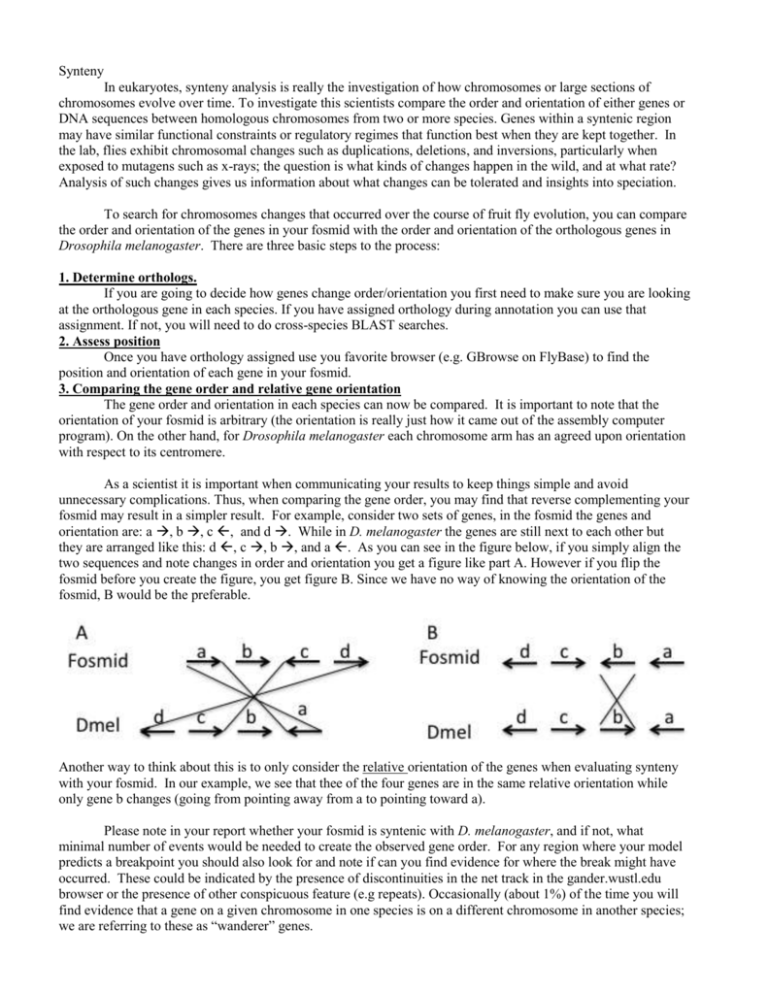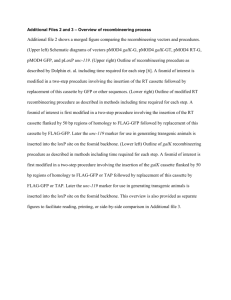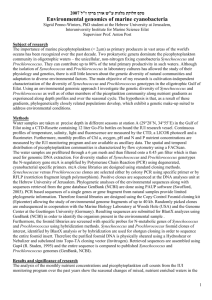Synteny
advertisement

Synteny In eukaryotes, synteny analysis is really the investigation of how chromosomes or large sections of chromosomes evolve over time. To investigate this scientists compare the order and orientation of either genes or DNA sequences between homologous chromosomes from two or more species. Genes within a syntenic region may have similar functional constraints or regulatory regimes that function best when they are kept together. In the lab, flies exhibit chromosomal changes such as duplications, deletions, and inversions, particularly when exposed to mutagens such as x-rays; the question is what kinds of changes happen in the wild, and at what rate? Analysis of such changes gives us information about what changes can be tolerated and insights into speciation. To search for chromosomes changes that occurred over the course of fruit fly evolution, you can compare the order and orientation of the genes in your fosmid with the order and orientation of the orthologous genes in Drosophila melanogaster. There are three basic steps to the process: 1. Determine orthologs. If you are going to decide how genes change order/orientation you first need to make sure you are looking at the orthologous gene in each species. If you have assigned orthology during annotation you can use that assignment. If not, you will need to do cross-species BLAST searches. 2. Assess position Once you have orthology assigned use you favorite browser (e.g. GBrowse on FlyBase) to find the position and orientation of each gene in your fosmid. 3. Comparing the gene order and relative gene orientation The gene order and orientation in each species can now be compared. It is important to note that the orientation of your fosmid is arbitrary (the orientation is really just how it came out of the assembly computer program). On the other hand, for Drosophila melanogaster each chromosome arm has an agreed upon orientation with respect to its centromere. As a scientist it is important when communicating your results to keep things simple and avoid unnecessary complications. Thus, when comparing the gene order, you may find that reverse complementing your fosmid may result in a simpler result. For example, consider two sets of genes, in the fosmid the genes and orientation are: a , b , c , and d . While in D. melanogaster the genes are still next to each other but they are arranged like this: d , c , b , and a . As you can see in the figure below, if you simply align the two sequences and note changes in order and orientation you get a figure like part A. However if you flip the fosmid before you create the figure, you get figure B. Since we have no way of knowing the orientation of the fosmid, B would be the preferable. Another way to think about this is to only consider the relative orientation of the genes when evaluating synteny with your fosmid. In our example, we see that thee of the four genes are in the same relative orientation while only gene b changes (going from pointing away from a to pointing toward a). Please note in your report whether your fosmid is syntenic with D. melanogaster, and if not, what minimal number of events would be needed to create the observed gene order. For any region where your model predicts a breakpoint you should also look for and note if can you find evidence for where the break might have occurred. These could be indicated by the presence of discontinuities in the net track in the gander.wustl.edu browser or the presence of other conspicuous feature (e.g repeats). Occasionally (about 1%) of the time you will find evidence that a gene on a given chromosome in one species is on a different chromosome in another species; we are referring to these as “wanderer” genes.









